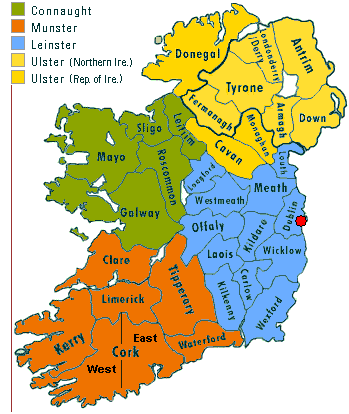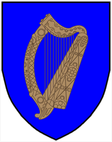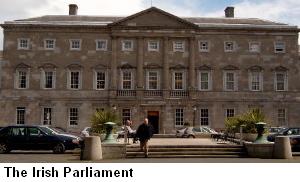Republic of Ireland: The State
1.
Overview
2.
Government
3.
Political Parties
4.
Local Government
5.
The Courts
6.
Police and Defence Forces
7.
Role of the Catholic Church in national affairs
Overview
 The
Republic of Ireland
(Irish:
Poblacht na hÉireann) is a constitutional parliamentary democracy. The name of the country
is often referred shortly to as Ireland (Irish:
Éire). Ireland is divided into four provinces: Connacht, Leinster, Munster and Ulster.
These were further divided into 32 counties for administrative purposes. Six
counties from Ulster remained under British sovereignty as Northern Ireland
following Ireland's partition in 1922. The Republic of Ireland has 26
counties, and these are used in political, cultural and sporting contexts. The capital
is Dublin.
The
Republic of Ireland
(Irish:
Poblacht na hÉireann) is a constitutional parliamentary democracy. The name of the country
is often referred shortly to as Ireland (Irish:
Éire). Ireland is divided into four provinces: Connacht, Leinster, Munster and Ulster.
These were further divided into 32 counties for administrative purposes. Six
counties from Ulster remained under British sovereignty as Northern Ireland
following Ireland's partition in 1922. The Republic of Ireland has 26
counties, and these are used in political, cultural and sporting contexts. The capital
is Dublin.
In the first two decades after Ireland achieved independence in 1922,
the institutions of the State were consolidated and a tradition of political
stability was established. The Constitution of 1937 and the Republic of
Ireland Act 1948 broke Ireland's last formal links with Britain. Ireland
remained neutral during the Second World War and does not belong to any
military alliance.
Language
Article 8 of the Constitution declares:
1. The Irish language as the national language, it is the first official
language.
2. The English language is recognised as the second official language.
 Flag
Flag

The national flag is a tricolour of green, white and orange. The flag is
rectangular in shape, the width being twice the depth. The three colours are
of equal size with the green next to the staff. Green and White are
traditionally the colours of those who fought for independence taking pride in
their Gaelic heritage, while orange is the colour of the British Prostestants
who used to rule Ireland until 1922.
 Emblem
Emblem
The harp has been regarded as the official symbol or coat of arms of Ireland
since medieval times. The heraldic harp is used by the Government, its
agencies and its representatives at home and abroad. It is engraved on the
seal matrix of the Office of the President as well as on the obverse of all
coinage. It features on the Irish euro coins.
Anthem
The text of Amhrán na bhFiann (Soldier's Song), consisting of three stanzas
and a chorus, was written by Peadar Kearney who also composed the music
together with Patrick Heeney. The chorus was formally adopted as the
National Anthem in 1926. A section of the National Anthem (consisting of the
first four bars followed by the last five) is also the Presidential Salute.
The National Day
Saint Patrick's Day, (17 March) is the National Day. He brought
Christianity to Ireland in the 5th century AD and established the first
Christian churches and monasteries in the country. 17th of March is
the date of his death. Tradition holds that it was the use of the shamrock by
Saint Patrick when preaching in Ireland that led to its adoption as an Irish
symbol.
Government
 The
law in Ireland is based on common law and legislation enacted by Parliament
under the Constitution. Regulations of the European Communities (Ireland joined the
European Union in 1973) have the force of law in Ireland. The Constitution of
Ireland sets out the form of government and defines the powers and functions of
the President, both Houses of the National Parliament and the Government.
The
law in Ireland is based on common law and legislation enacted by Parliament
under the Constitution. Regulations of the European Communities (Ireland joined the
European Union in 1973) have the force of law in Ireland. The Constitution of
Ireland sets out the form of government and defines the powers and functions of
the President, both Houses of the National Parliament and the Government.

It also defines the structure and powers of the Courts
and outlines the fundamental rights of citizens. The definition of rights
covers five broad headings: Personal Rights, The Family, Education, Private
Property and Religion.
The President is the Head of State. Where there is more
than one candidate for the office, the people elect the President by direct
vote. The
presidency is open to all citizens who are at least 35. A candidate may also be
chosen by a consensus among the political parties, in which case it is
unnecessary to hold an election. A President may only serve for two
terms. The current President, Mary McAleese (on the picture), was elected for a
seven year term in November 1997.
There are fifteen Government Departments each headed by a Minister who
collectively form the Government. Executive power is exercised by the Government, which is responsible to the Dáil (House of
Representatives). The Head of the Government is the Taoiseach (Prime
Minister) while the Tánaiste is the Deputy Prime Minister.
There are two Houses of Parliament, known as Dáil Éireann
(House of
Representatives) and Seanad Éireann (Senate). The Dáil has 166 members. They
are elected on a system of proportional representation (unlike in the UK) by universal
suffrage (18 years of age and above). Elections take place at least once every
five years. The main political parties in the
Dáil are Fianna Fáil, Fine Gael, the Labour Party, Progressive Democrats,
the Green Party, Sinn Féin and the Socialist Party. The present government
is made up of a coalition between Fianna Fáil and the Progressive Democrats.
The Seanad has 60 members, eleven of whom are nominated by the Taoiseach
(Prime Minister) while the rest are elected from a number of vocational
panels and by graduates of universities. The Seanad may initiate or revise
legislation, but the Dáil has the power to reject any such amendments or
proposed legislation.
Elections: Senate - last held 16 and 17 July 2002 (next to be held by
July 2007); House of Representatives - last held 17 May 2002 (next to be
held by May 2007)
Election results: Senate - seats by
party:
Fianna Fail 30
Fine Gael 15
Labor Party 5
Progressive Democrats
4
Independents and others 6
House of Representatives - seats by
party:
Fianna Fail 81
Fine Gael 31
Labor Party 21
Progressive Democrats
8
Green Party 6
Sinn Fein 5
Others 14
Political Parties
Fianna Fáil, the Republican
Party, is well represented in urban and rural Ireland. Since 1932 it has
been the largest party in the Dáil. Its aims include securing in peace and
agreement the unity and independence of Ireland, and the development of a
distinct national life in accordance with the diverse traditions of the
Irish people. It is part of the Union for Europe group in the European
Parliament.
Fine Gael, the second
largest party, is based on the principle of encouraging enterprise and
social justice with decision-making devolved to the appropriate level. A
core ideal of the party is reconciliation with and between the peoples of
the island of Ireland, and the belief that this is not achieved through
confrontation. It is part of the European People's Party in the European
Parliament.
The
Labour Party is affiliated to the
Socialist International Party and is a member of the Party of European
Socialists (PES) in the European Parliament. It seeks to build a society
free from deprivation and based on the principles of democracy, equality,
participation and co-operation.
The
Progressive Democrats were
established with the aim of providing Ireland with a modern, forward-looking
liberal party in the European mould and is working to develop the role of
the State in the economic and social life of the country.
The
Green Party is a political
party associated with Green Parties in over 30 other countries. It stands
for protection of the environment, community decision-making, freedom of
information, open government and peace through disarmament. The Green Party
motto is 'Think Globally, Act Locally'. The Party is represented at local,
national and European Parliament level.
Sinn Féin is an Irish republican
party, based in Northern Ireland (where it is much more popular). Its objectives are the reunification of Ireland, political
independence and national sovereignty.
The
Socialist Party
campaigns in the interest of ordinary workers, the unemployed and young
people.
Local Government
The local government system is administered by 114 local authorities and
is undergoing a process of renewal and reform.
The services provided by
the local authorities can be described under eight main headings: housing
and building; road transportation and safety; water supply and sewerage;
development incentives and controls; environmental protection; recreation; education,
and health and welfare. Education, health and welfare services are however primarily delivered at
local level by other public agencies. The local government reform programme
has seen local government expand its community development role and widen
its sphere of influence in locally delivered public services. Local
government is funded partly by central government and partly by local
sources including motor tax proceeds, rates (on commercial property) and
local charges such as refuse, rents and so on.
The Courts
Irish law is based on Common Law, was modified by subsequent legislation
and by the Constitution of 1937. In accordance with the Constitution,
justice is administered in public by courts established by law. The
President appoints judges, on the advice of the Government. Judges are
usually senior practising lawyers. Summary offences and minor civil cases
are dealt with by the District Court presided over by a District Judge. More
serious cases are heard by the Circuit Court, presided over by a judge who
sits with a jury of twelve citizens in criminal cases. The most
serious cases are heard by the High Court, presided over by a judge; when
trying criminal cases it sits with a jury and is known as the Central
Criminal Court. The court of final appeal is the Supreme Court which
has the final say in the interpretation of the Constitution.
Police and Defence Forces
The national police force (An Garda Síochána), established in 1922,
comprises almost 12,000 men and women. The general direction, management and
control of the service is, subject to regulations made by the Minister of
Justice, Equality, Law and Reform, vested in a Commissioner appointed by the
Government.
An Garda Síochana is unarmed with the exception of some
specialized units. Among developed countries Ireland has one of the lowest
levels of serious crimes of violence while the crime detection rate is
comparable to that of other European countries. Since 1989, An Garda
Síochána have served in United Nations (UN) missions in Namibia, Angola,
East Timor, El Salvador, Cambodia, Cyprus, Western Sahara, Somalia,
Mozambique, the former Yugoslavia, Bosnia and Herzegovina, Tajikistan and
Eastern Slavonia. They have also served under the EU flag in the former
Yugoslavia, Macedonia and Eastern Slavonia and have provided monitors for
the South African and Palestine elections. An Garda Síochána are currently
serving in a UN mission in Cyprus and a EU mission in Bosnia and
Herzegovina.
The Defence Forces
consists of a Permanent Defence Force (PDF) which comprises the Army, Naval
Service and Air Corps, with a strength of 10,500 personnel. The Reserve
Defence Forces (RDF) has a strength of 12,500 personnel. The Mission of the Defence Forces
is to contribute to the security of the state by providing for military
defence of its territorial integrity and to fulfil all roles assigned by
Government. The roles include defending the state against armed aggression;
to participate
in multinational peace support, crisis management and humanitarian relief
operations in support of the United Nations. The Defence Forces will also carry out such other duties
as may be assigned from time to time e.g. assistance on the occasion of
natural or other disasters.
Defence Forces involvement in peacekeeping missions began in 1958. Irish
military personnel have completed over 50,000 tours of duty on 55 Peace
Support Operations throughout the world. Currently there are sizeable
contingents of troops serving in Liberia and Kosovo as well as smaller
elements in several other areas including, the Middle East, Bosnia and
Herzegovina, Afghanistan, East Timor, Cyprus, Western Sahara, Congo and
Kuwait.
Role of the Catholic Church in national affairs
Church attendance has declined rapidly in Ireland in recent years. As with other
predominantly Roman Catholic European states (e.g., Italy), the Irish
state has undergone a period of legal secularisation. In 1972, the "special
position" of the Catholic Church in Ireland
was deleted from the Irish constitution.
In
1995, after a seventy-year ban, a constitutional amendment allowed divorce in
the Republic.
In 1983, the
Irish constitution was amended to recognise "the right to life of the unborn",
subject to qualifications concerning the "equal right to life" of the mother. In
the 1990s the Supreme Court interpreted the qualifications in the amendment as
allowing
abortion in limited circumstances. However, the Oireachtas
has not introduced a law enabling abortion to take place in those circumstances
allowed by the court. A subsequent series of constitutional amendments allow
Irish citizens access to information about abortion and to travel freely to get
abortions outside Ireland.
sources:
www.eu2004.ie
Wikipedia:
Republic of Ireland;
Politics of the Republic of Ireland
credits:
The text was composed by using
the relevant materials of...
1.
www.eu2004.ie, the official
website of the Irish Presidency of the EU
© Government of Ireland 2004
2. Role of the Catholic Church...:
Wikipedia The Free Encyclopedia
under
GNU Free Documentation Licence.
 The
Republic of Ireland
(Irish:
Poblacht na hÉireann) is a constitutional parliamentary democracy. The name of the country
is often referred shortly to as Ireland (Irish:
Éire). Ireland is divided into four provinces: Connacht, Leinster, Munster and Ulster.
These were further divided into 32 counties for administrative purposes. Six
counties from Ulster remained under British sovereignty as Northern Ireland
following Ireland's partition in 1922. The Republic of Ireland has 26
counties, and these are used in political, cultural and sporting contexts. The capital
is Dublin.
The
Republic of Ireland
(Irish:
Poblacht na hÉireann) is a constitutional parliamentary democracy. The name of the country
is often referred shortly to as Ireland (Irish:
Éire). Ireland is divided into four provinces: Connacht, Leinster, Munster and Ulster.
These were further divided into 32 counties for administrative purposes. Six
counties from Ulster remained under British sovereignty as Northern Ireland
following Ireland's partition in 1922. The Republic of Ireland has 26
counties, and these are used in political, cultural and sporting contexts. The capital
is Dublin.  Flag
Flag
 Emblem
Emblem The
law in Ireland is based on common law and legislation enacted by Parliament
under the Constitution. Regulations of the European Communities (Ireland joined the
European Union in 1973) have the force of law in Ireland. The Constitution of
Ireland sets out the form of government and defines the powers and functions of
the President, both Houses of the National Parliament and the Government.
The
law in Ireland is based on common law and legislation enacted by Parliament
under the Constitution. Regulations of the European Communities (Ireland joined the
European Union in 1973) have the force of law in Ireland. The Constitution of
Ireland sets out the form of government and defines the powers and functions of
the President, both Houses of the National Parliament and the Government.
